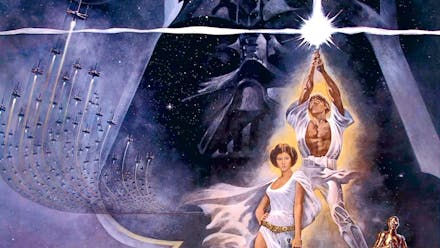It's tricky, but try to imagine a time before Star Wars. Close your eyes, concentrate hard, rewind those famous scrolling credits until there's just blackness. Good. Back in that dark, pre-enlightenment age, 20th Century Fox conducted some market research on their forthcoming sci-fi adventure.
Researchers armed only with a title and brief synopsis came back with some worrying results: only males under 25 expressed a desire to see a film called Star Wars. As a direct result of this research, Star Wars was deliberately packaged to attract older and female cinemagoers: the humans were pushed centre-stage and the film's epic, fairy-tale qualities were emphasised in the publicity material. When Star Wars came out in the summer of 1977 it had been focus-grouped, and to great effect — everybody went to see it.
By November, it had dethroned Jaws in the all-time box office charts, a position it held until Independence Day. Blimey, even the novelisation sold two million copies, and let's not get started on the merchandising. So what happened? After all, nobody's attributing Star Wars' epoch-making, culture-shifting success to a wily decision to put Princess Leia on the posters. The answer is timing.
The 1970s, Hollywood's second golden age, were characterised by baby-boomer film students making pictures personal and dark enough to reflect the political morass of post-Watergate, in-Vietnam America. Though The Exorcist and Jaws are credited with kicking down the doors of the Blockbuster Age, these were not family films. Star Wars was. George Lucas, feted after American Graffiti had made $55 million off a $1.2 million budget, started writing his moralistic space opera in 1973. He worked on the script for two and a half years in a back room containing a Wurlitzer jukebox and a portrait of Sergei Eisenstein, during which he could never remember how he spelt all those crazy names (Wookiee was different every time he wrote it). It's said that he based maverick Han Solo (bearded, originally) on his pal Francis Coppola and Darth Vader on Richard Nixon.
Influenced by Joseph Campbell's writings on the power of ancient mythology, Lucas created a cosmic Western, the "black hats" replaced by Vader and the evil Empire, and the "white hats" by farmboy Luke Sky walker (Solo was the equivalent of the drunken gunslinger). Lucas' movie brat mates thought he was nuts, and indeed, by the end of a tortuously difficult shoot at Elstree Studios, he very nearly was.
Meanwhile, in an old warehouse near Van Nuys airport, the newborn Industrial Light And Magic had spent $5 million of the $9.5 million budget and not produced a single usable effects shot in one year of working. Of course when they did, ILM redefined movie effects as sure as the finished film would redefine the experience of "going to the pictures ". We all know why Lucas felt the need to digitally tidy up his original trilogy for the great, money-hoovering 1997 reissue, but it set a worrying precedent for The Phantom Menace, where too much technology smothered characterisation and story.
Star Wars' timeless appeal lies in its easily identified, universal archetypes — goodies to root for, baddies to boo, a princess to be rescued and so on — and if it is most obviously dated to the 70s by the special effects, so be it. We all love the stormtrooper banging his head! To remove that digitally would be a crime. Mark Hamill said he felt "like a raisin in a giant fruit salad" when making Star Wars; 20 years later, Liam Neeson almost retired from screen acting after his experiences on The Phantom Menace. But George Lucas does not make actors' films — his interest is in the Star Wars myth, not the cult of some Hollywood star.
Isn't it ironic then, that Star Wars remains a rewatchable classic because of the characters and the performances behind them (especially Ford, Fisher, and James Earl Jones). Sure, you can snigger at R2-D2 trundling along the sand like a wheelie-bin, but his signature beeps and clucks are as essential to the personality and momentum of the film as the rousing John Williams score. Just as it's hard to remember what cinema was like before Star Wars, it's impossible to view the original film in isolation now. In 1977, it was not Episode IV, it was a self-contained pleasure that made it okay again to cheer at the screen.








